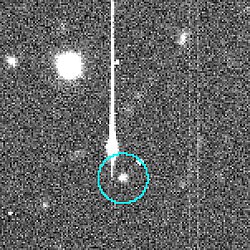Setebos (moon)

Discovery image of Setebos (encircled)
|
|
| Discovery | |
|---|---|
| Discovered by | |
| Discovery date | July 18, 1999 |
| Designations | |
| Adjectives | Setebosian |
| Orbital characteristics | |
|
Mean orbit radius
|
17,418,000 km |
| Eccentricity | 0.5914 |
| 2225.21 d | |
| Inclination | 158° (to the ecliptic) |
| Satellite of | Uranus |
| Physical characteristics | |
|
Mean radius
|
24 km (estimate) |
| ~7200 km² (estimate) | |
| Volume | ~58,000 km³ (estimate) |
| Mass | ~7.5×1016kg (estimate) |
|
Mean density
|
~1.3 g/cm³ (assumed) |
| ~0.0204 km/s (estimate) | |
| ? | |
| ? | |
| Albedo | 0.04 (assumed) |
| Temperature | ~65 K (estimate) |
Setebos (/ˈsɛtᵻbʌs/ SET-ə-bus) is one of the outermost retrograde irregular satellites of Uranus. It was discovered on 18 July 1999 by John J. Kavelaars et al. and provisionally designated S/1999 U 1.
Confirmed as Uranus XIX, it is named after the god worshipped by Caliban and Sycorax in William Shakespeare's play The Tempest.
The orbital parameters suggest that it may belong to the same dynamic cluster as Sycorax and Prospero, suggesting common origin. However, this suggestion does not appear to be supported by the observed colours. The satellite appears neutral (grey) in visible light (colour indices B-V=0.77, R-V=0.35), similar to Prospero but different from Sycorax (which is light red).
Ironically, a crater on Umbriel is also named after Setebos, but with the spelling Setibos.
...
Wikipedia
